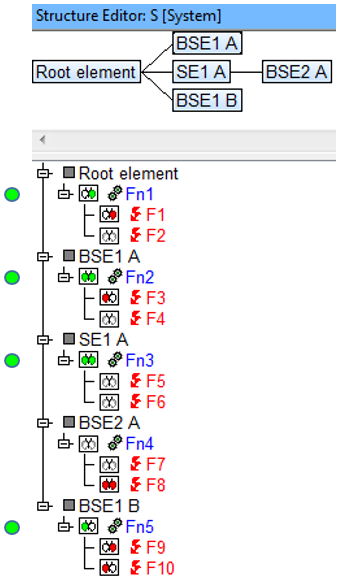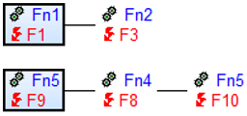Search:
Linked functions with linked failures which are not compliant with VDA
Explanation:
A search will be made for linked functions which have linked failures that are not compliant according to the VDA manual. VDA compliancy in this context means that the failure links must match the existing function links.
Note: a separate QR covers linked functions with oppositely linked failures.
Example:
Abbreviations
- ASIL = Automotive safety integrity level
- BF = Base failure of a base function
- BFn = Base function of a base structure element
- BSE = Base structure element
- Cl Prc = Classification for process characteristic
- Cl Prd = Classification for product characteristic
- Cl Req = Classification for requirement
- CM = Control method
- DA = Detection action
- DC = Diagnostic coverage
- DSCF = Dangerous safety critical failure
- Er Det = Error detection
- Er Resp = Error response
- F = Failure
- FIT = Failure in time
- Fn = Function
- FSM = Functional safety management
- IE = Inspection equipment
- LF = Latent fault
- LFM = Latent fault metric
- OC = Operating condition
- PA = Preventive action
- PE = Process element
- PFH = Probability of failure per Hour
- PMHF = Probabilistic metric for random hardware failures
- PrcC = Process characteristic
- PrdC = Product characteristic
- QM = Quality method
- QR = Quality rule
- Req = Requirement
- RMR = Risk Matrix Ranking
- RP = Reaction plan
- SE = Structure element
- SE ErDet = Structure element for error detections
- SE ErResp = Structure element for error responses
- SFF = Safe failure fraction
- SG = Safety Goal
- SIL = Safety integrity level
- SM = Organisational-SE for “safety mechanisms”
- SPF = Single point fault
- SPFM = Single point fault metric
- TF = Top failure of a top function
- TFn = Top function at root element
- TS = Test sample

- Each of the five structure elements contains a function each of which have two failures anchored. See the following image:
- The hot-click icon that is left of the function name (Fn..) indicates whether it is connected in one or more function nets. All but Fn4 are linked in function nets. The actual (and only) function net for this example can be seen below.
![]()
- The hot-click icon to the left of the failure name (F..) indicates whether it is connected in one or more failure nets. The following two failure nets exist in this example.

- This Quality Rule searches for all linked functions (therefore Fn4 is not included), firstly whose anchored failures are not linked in failure nets (
 ). If a failure of a linked function is itself not linked in a failure net it is not VDA-compliant. Secondly, a failure is also not compliant with VDA if it is linked in a failure net but it is not connected to match that of the function net links. As mentioned above though, a different Quality Rule covers a similar search, whereby linked failures are anchored at linked functions, but in opposing directions.
). If a failure of a linked function is itself not linked in a failure net it is not VDA-compliant. Secondly, a failure is also not compliant with VDA if it is linked in a failure net but it is not connected to match that of the function net links. As mentioned above though, a different Quality Rule covers a similar search, whereby linked failures are anchored at linked functions, but in opposing directions. - For this QR the functions Fn1, Fn2 and Fn3 (which have unlinked failures F2, F4, F5 and F6) are considered. The unlinked failure F7 is not relevant to this search as it is anchored at an unlinked function (Fn4), and unlinked functions are not taken into account.
- Whether or not the remaining linked failures are VDA-compliant can be seen when comparing them to their corresponding function links. Starting with function Fn1, which is linked to Fn2: VDA compliancy occurs if in the failure net the failure F1 is linked to a failure at Fn 2, which it is (F3). VDA compliance between F1 and F4 is not considered as F4 is not linked in either direction.
- F3 is linked to F1 but not to F5 or F6, the anchored failures to function Fn3. This means that Fn2 and Fn3 will be hits in this example.
- As the linked failure F8 is anchored to an unlined function Fn4, it is not considered in this search. Unlinked functions are not considered.
- By checking the function net image above, you can see that Fn5 is only linked to Fn3. This means that the failures anchored at Fn5 must be linked with at least one failure anchored to Fn3. This is not the case for either F9 or F10. Therefore, Fn5 is also a hit.
Search result: ![]()
There are 4 hits here in total: Fn1, Fn2, Fn3 and Fn5.


